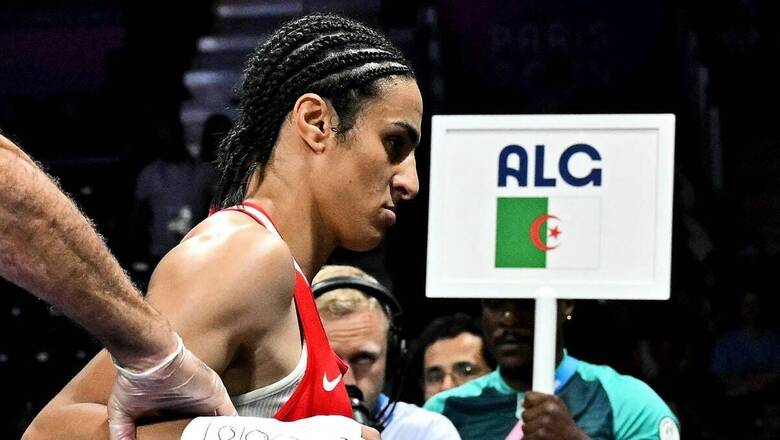
views
Between the idea
And the reality
Between the motion
And the act
Falls the shadow.
— TS Eliot in ‘The Hollow Men’
To fit Eliot into the free-for-all boxing ring of gender identity that the Paris Olympics has descended into, one might rephrase him: ‘Between XX and XY, falls the shadow.’
From Elon Musk to Rowling, from Emmanuel Macron to Georgia Meloni, everybody is throwing punches at the torrid global debate on whether those with male hormones, genetic makeup, or genitalia should compete with women.
The parody of the Last Supper and trans performances at the Games opening kicked off the controversy. But the real gender fistfight began after Algeria’s Image Khelif, who was ruled out of some previous competitions for having XY chromosomes and male hormones, clobbered Italy’s Angela Carini in women’s boxing, a sport which involves heavy physical contact.
The International Olympic Committee and organisers in France vocally defended Khelif, saying no rule was violated. But Italian PM Meloni stood by Carini, and the Western Right erupted with outrage at ‘men’ winning women’s sport.
The unspoken core of the problem may lie in the Abrahamic Western world’s refusal to accept anything other than the man-women binary. There are passages in the Bible, Jewish texts, and the Quran which occlude or obstruct non-binary sex and gender ideas.
Non-Abrahamic religions and ways of life like Sanatan Dharma are far more accepting, with mainstream spiritual concepts like the ‘Ardhnarishwar’, or the fusing of Shiv and Shakti.
The Narendra Modi government brought the Transgender Persons (Protection of Rights) Act, 2019, which prohibits discrimination against transgenders in relation to opportunities for education, job, health care services, and access to services, and also recognises one’s right to be transgender.
Since 2009, the Election Commission has added the option of ‘Others’ to voter registration.
In 2014, the Supreme Court recognised the group as Third Gender, stating, “Recognition of transgenders as a third gender is not a social or medical issue, but a human rights issue.”
Although the definition of transgender in the 2019 Act has been left a bit vague — “a person whose gender does not match with the gender assigned to that person at birth” —it could be made more specific and widened.
The point is, a Third-Gender Olympics, like the Paralympics, could solve the problem of unjust competition. No one has to then gatecrash women’s events and bathrooms.
If it looks hard, the Judeo-Christian world may find enough empathy for the Third Gender in their religious texts as well.
Rabbi David J Meyer writes: An entire tractate of Talmud, in fact, is devoted to the laws and rituals of bringing the First Fruits, detailing the ornamentation of the offerings, and how the gifts would be offered by the men and women.
During the course of this discussion, the text poses a question that many today might find quite stunning. While reviewing the differing obligations of men and women when it comes to offering the first fruits of Shavuot, the rabbis pondered the circumstances for those who fall outside the normative identities of male or female. Here’s how the discussion begins:
“An androgynous, who presents both male and female physical traits, is in some ways like men and in some ways like women. In some ways, they are like both men and women, and in other ways, like neither men nor women.” (Bikkurim 4:1)
Jewish legal tradition identifies no fewer than six distinct “genders”, certainly assuming as normative the male and female, but including as well designations which we now refer to as “intersex” identities. To use the Hebrew terms: the androgynous, one who has both male and female characteristics, the tumtum, one whose biology is unclear, the aylonit, who identified as female at birth, but at puberty, develops male characteristics, and the saris, who appears as male at birth, but later takes on more typically female biology.
Even in Christian scripture, there are many affirming passages for trans and gender non-conforming people. There are women warriors, Jesus’s kind words for eunuchs, and a passage in Isaiah about eunuchs being given a name and a family.
Isaiah 56:3-5
As Let no foreigner who is bound to the Lord say,
“The Lord will surely exclude me from his people.”
And let no eunuch complain,
“I am only a dry tree.”
For this is what the Lord says:
“To the eunuchs who keep my Sabbaths,
who choose what pleases me
and hold fast to my covenant—
to them I will give within my temple and its walls
a memorial and a name
better than sons and daughters;
I will give them an everlasting name
that will endure forever.
Creating a framework for a Third Gender Olympic Games is not going to be easy. Gender can be infinitely complex, and often confused with sexual choice or orientation.
When it comes to sports, physical attributes are paramount. The Hell’s Angels can’t walk in saying, “I feel like a young female wrestler today.”
But just like the Paralympics, it is possible to sensitively bring the immense physical diversity that exists between the strictly male and the female under one umbrella of an overarching event.
And there, between the polar certainties, will fall the joyous, tormentless sporting shadow.
Abhijit Majumder is a senior journalist. Views expressed in the above piece are personal and solely those of the author. They do not necessarily reflect News18’s views.




















Comments
0 comment